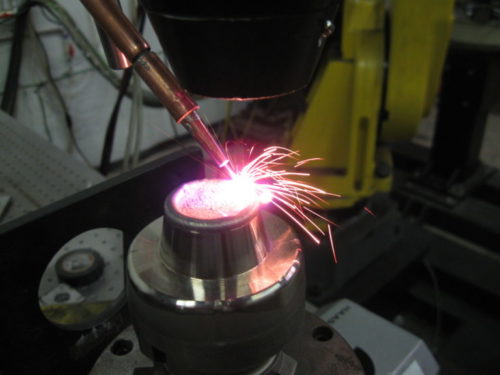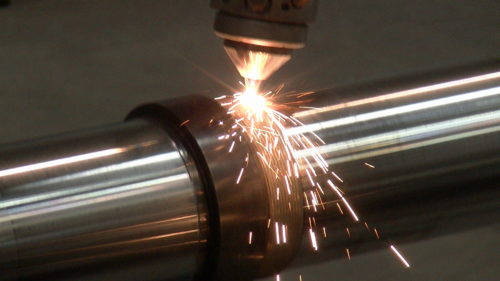What Metals Can You Braze?
Comments Off on What Metals Can You Braze?
Brazing is used to join metal parts and can be applied to a wide array of materials, like brass, copper, stainless steel, aluminum, zinc-coated steel, and ceramics. Laser brazing offers some distinct advantages in applications that require the joining of non-similar metals.
What Is Brazing?
Brazing is a process by which non-ferrous filler metals or braze alloys are melted between two or more close-fitting base metal parts to form a joint. The technique involves heating components above the braze alloy melt temperatures and below the melting temperature of the base metal, allowing capillary action to distribute the molten filler throughout the joint between the two pieces to be brazed. As the braze alloy cools, a strong joint or seal forms.
Laser brazing replaces the use of an oxy-acetylene flame, the most common heat source in other brazing techniques, with a laser to allow for more localized heat application.
What Metals Can Be Brazed?

- Brass
- Copper
- Stainless steel
- Aluminum
- Zinc-coated steels
It is also effective in joining mixed materials like tungsten carbide or silicon nitride—a highly durable ceramic—to itself or metal parts.
Many HVAC and A/C units are made of aluminum components because of the metal’s high strength, light weight, and resistance to rust. Brazing is commonly used in these applications to provide reliable, leak-proof connections. However, aluminum is notoriously challenging to work with as a result of its low melting temperature and its reliance on selecting the appropriate alloy and flux for the specific application. In these instances, laser brazing offers an advantage over traditional brazing because in some cases, it can be used without flux, and its more precise approach to the heating process allows for filler material to be targeted while maintaining the integrity of the aluminum base.
Filler materials in laser brazing are often made of aluminum bronzes, a corrosion-resistant, copper-based alloy noted for its strength.
<Find out how laser hardening is used for industrial components.>
Advantages of Laser Brazing for Mixed Metals
Brazing is regularly used in place of welding in applications that require the joining of non-similar metals when differences like melting temperature or appreciable solubility make them incompatible without the use of an interface layer.
Two key advantages of using laser brazing for mixed metal applications include:
Lower Temperatures
Laser brazing works to localize heat dispersion by using independent beams to heat both the filler material and base metals more precisely, helping to reduce part distortion as compared to the traditional torch, furnace, and arc brazing techniques. This targeted heating allows for greater energy efficiency and improves processing times.
Reduced Costs
Laser brazing does not require unique coils or parts for different applications, omits the need for flux, improves energy efficiency, and increases the processing rate due to reduced cool-down times after brazing. Additionally, the process can be automated to improve part quality. These reductions in manufacturing materials help lower total production costs.
Brazing is an invaluable alternative to welding when it comes to joining metals whose metallurgy does not align. More specifically, laser brazing provides a host of benefits that lead to greater efficiency and lower production costs in mixed metal applications.
For more information on the benefits of laser brazing or to learn about our other laser processing services, contact the team at Titanova today.
What’s the Difference Between Hardfacing and Cladding?
Comments Off on What’s the Difference Between Hardfacing and Cladding?

Hardfacing vs. Cladding Process
Though hardfacing and cladding are surface overlay processes that are different only in material characteristics that meet different requirements, they both can be achieved using similar processes:
- Lasers
- Thermal spray
- Flux-cored arc welding or FCAW
- Plasma Transfer Arc [PTA] welding
The choice between hardfacing and cladding comes down to the characteristics you want to impart, the materials involved, and an understanding of the environment that the surface is subjected too. In hardfacing, the heavy, wear-resistant carbide/metal deposit can be applied by laser, thermal spraying, spray-fuse, or welding. Thermal spraying is best for items sensitive to heat distortion, as opposed to spray-fuse that requires flame spraying and fusion with a torch. Thermal spray is not a welding process; therefore, bond strength is very low as compared to a welded or brazed overlay. Traditional weld hardfacing can be used to apply a very thick layer (up to 10’s of mm) of wear-resistant material. Laser hardfacing has benefits over the other processes primarily because it is a welding process that has lower heat, lower dilution, and less dissolution of the carbide. This all enables the ability to achieve very thin hardfacing overlays.
Cladding is a weld overlay process yielding an entirely new surface that can be used with a large variety of overlay materials in different forms such as powder, wire, or cored wire. Again, traditional overlay processes can be used as listed above. Just like laser hardfacing, laser cladding has benefits over the other processes primarily because it is a welding process that has lower heat and lower dilution. This all enables the ability to achieve very thin clad overlays.
Laser hardfacing and cladding are used in almost every industry market with applications such as:
- Oil and gas
- Automotive
- Construction equipment
- Agriculture
- Mining
- Military
- Energy generation
- Repair and refurbishment of tools, turbine blades, and engines
Laser hardfacing and laser cladding both provide the advantages of little thermal distortion, high-productivity, and cost effectiveness.
Use of Lasers in Hardfacing and Cladding Processes
Using lasers as a heat source in hardfacing and cladding provides precision and the lowest amount of chemical dilution to weld two materials. It offers a cost-effective way to use less expensive substrate materials by applying a weld overlay, which provides the corrosion, oxidation, wear, and temperature resistance. The high production rate with which products can be completed combined with material cost advantages make laser cladding and hardfacing a popular choice for many industries.
<Learn how Titanova performs laser clad overlays of Cobalt 6 – Stellite® for a variety of clients.>
Cutting-Edge Technology and Industry-Leading Quality
Since 2008, Titanova has been offering full-service laser material processing capabilities, including laser welding, laser cladding, and laser hardfacing, performed in our ISO 9001:2015 certified laser job shop. We are proud to serve a wide variety of industries, from aerospace, nuclear energy, and chemical processing to food processing, steel manufacturing, and transportation. Our experience and expertise in metallurgy, laser processing, and quality assurance provide innovative, cost-effective, and rapid solutions for our customers.
When you need precision laser materials processing with the highest standards in quality for your hardfacing and cladding projects, Titanova is here to help. For more information on our capabilities, or to submit a request for quote, contact us today.
